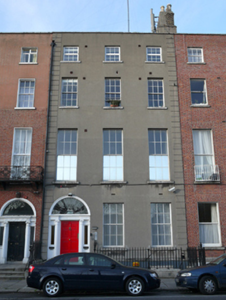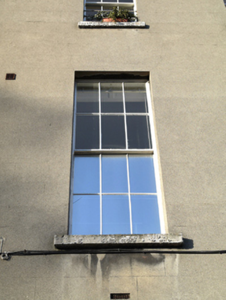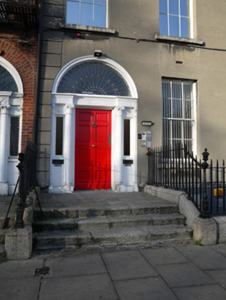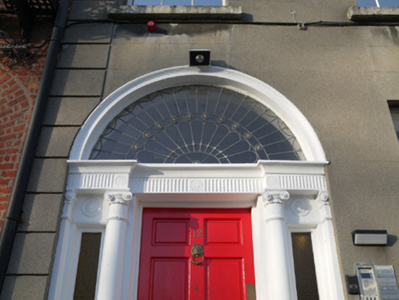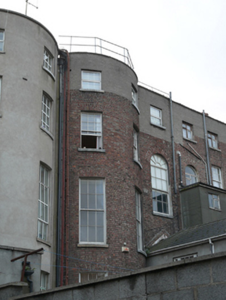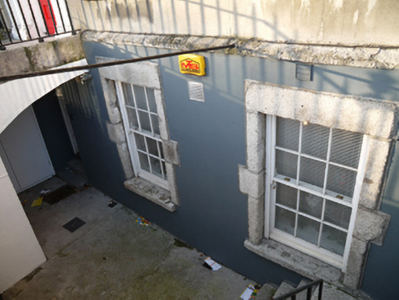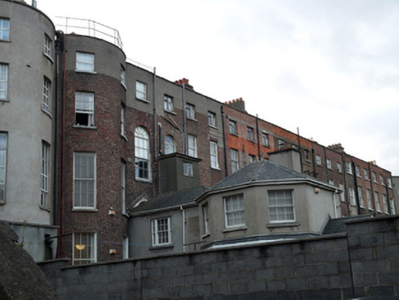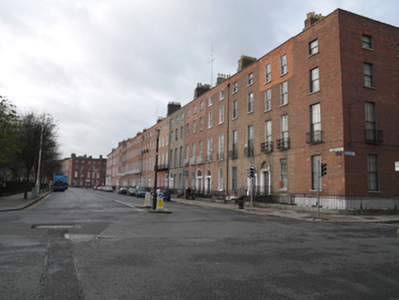Survey Data
Reg No
50010811
Rating
Regional
Categories of Special Interest
Architectural, Artistic
Original Use
House
In Use As
Office
Date
1790 - 1795
Coordinates
316041, 235534
Date Recorded
05/12/2011
Date Updated
--/--/--
Description
Terraced three-bay four-storey house over raised basement, built c.1792, now in use as offices, having full-height bowed bay and two-storey return terminating in pentagonal bay to rear (north) elevation. Double-pile slate roof, hipped to west to front (south) elevation, with two hipped projections set perpendicular to rear. Shared brown brick chimneystack having clay pots to east party wall, hidden behind rendered parapet wall with granite coping. Replacement rainwater goods to west of façade. Ruled-and-lined rendered walls having channelled quoins to granite plinth course over painted rendered wall to basement. Red brick laid in Flemish Bond to rear, rebuilt from third floor sill level upwards with machine-made brown brick. Rendered walls to return. Flat-arch window openings having flush reveals, granite sills and replacement six-over-six pane timber sliding sash windows to front and rear, replacement uPVC windows to top floor. Painted granite block-and-start architrave surround to basement window. Gauged brick round-headed window opening to second floor stairwell to rear, with timber sliding sash window. Round-headed door opening with rendered reveal and painted stone Ionic doorcase, and having replacement timber panelled door flanked by engaged Ionic columns, plain glazed sidelights having rosettes over and quarter engaged responding Ionic pilasters supporting stepped fluted lintel cornice, and replacement fanlight. Door opens onto granite platform with three granite steps bridging basement. Platform and basement enclosed by original wrought-iron railings and cast-iron corner posts set on moulded granite plinth wall to street having matching iron gate providing basement access. Granite steps and railings to basement. Recent timber door under entrance platform.
Appraisal
This Georgian townhouse is relatively intact, with a fine early doorcase adding a decorative focus. The rendered facade is neatly framed by quoins. The retention of mostly timber sash windows adds to the heritage value of the building, and the retention of the stone plinth, railings and gate serving the basement, and of stone steps to the main entrance, enhance the setting of this grand house which stands within an important urban landscape. Mountjoy Square was built on lands formerly belonging to Saint Mary’s Abbey and laid out in 1790 by Luke Gardiner II, completed by 1818. Originally called Gardiner Square, it was planned to develop a strong vista from Custom House to Mountjoy Square and thence to the planned Royal Circus. Unlike other Georgian squares in the city, this example was more carefully laid out with a unified parapet height and the east-west approaches offset to create a sense of enclosure. After falling into serious neglect and dereliction throughout the twentieth-century resulting in the loss of one third of its original buildings, the square has since been repaired.

